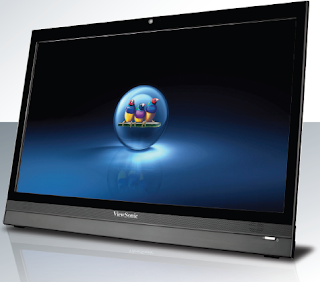 |
|
Tabitors can serve as signage and public kiosks—
and as cloud-based access and computing devices |
The year gone by was quite encouraging for the hybrid segment, which got spicier with the continued success of phablets, led by Samsung’s Note—and the reasonably fair buzz generated around Microsoft’s notelet Surface.
What do we call a device that doubles up both as a giant tablet and a monitor? A smart display—as its maker ViewSonic has chosen to—or a tabitor?
ViewSonic generated much buzz, after it actually conjured up devices like VSD 220 and VSD 240, which are both monitor and Android-powered large-screen tablets that mimic features of all-in-one PCs. Not surprisingly, tech reviewers were quick enough to pour their thoughts on these new hybrids on-the-block.
One thing that most of tech reviewers have seemed to agree upon is the innovativeness of the concept, even if opinions varied on the extent of the devices’ functionality, especially that of VSD 220.
But then, it’s quite ok for OEMs to not get it right the very first time, provided they are eager to make rapid improvements in subsequent versions. To the due credit of ViewSonic, it has been quick enough to make some key improvements in VSD 240, if specs are to tell a story. That VSD240 bagged the “Best of CES” award from a leading tech blog for being the most innovative gadget at CES 2013 held earlier this month in Las Vegas, could also be considered a positive. As compared to VSD 220’s 1GHz dual-core Cortex A9 processor, VSD 240 is powered by a 1.7 GHz quad-core nVIDIA processor, and of course sports a 24-inch screen as compared to 22-inch in the earlier model.
Indeed, ViewSonic faces a challenge as it works to make the improvements. In today’s ultra-competitive tech devices world, the first-mover advantage doesn’t last long. It is more possible today than ever before for a competition to bring out an improved version faster than the innovator. Innovation with speed is therefore a key.
In the more immediate term, a greater application potential for the ViewSonic tabitors lies in segments such as signage, hospitality and public kiosks. To compete in the enterprise and consumer segments, it could be at a disadvantage being pitted against the AIOs. While the company hopes to cover ground by way of a Citrix virtualization solution, there would be challenges to overcome nevertheless.
A recent company release quoted Kuldeep Ramaiya, Country Manager, ViewSonic India, “VSD 240 makes it easy for people to embrace the post-PC transition and interact within a cloud-connected world in a brand new way, while still enjoying the robust feature set people expect of ViewSonic.”
A more attractive pricing can help, as would a pricing segmentation strategy, and the good thing is that ViewSonic has already taken some positive steps on the front. It has, for instance, a 19-inch version of its tabitor coming up—the VSD 190. One would expect it to be priced lower than VSD 220, which is currently priced at Rs 31,999 and is considered a tad higher, especially when having to compete against the AIOs in the consumer segment.
© 2018 BusinessandMarket.net, the insights service provider focused on IT and telecom, offering rich analysis done by subject matter specialists.
To make a service inquiry, click http://www.businessandmarket.net/p/your-inquiry.html
To make a service inquiry, click http://www.businessandmarket.net/p/your-inquiry.html

